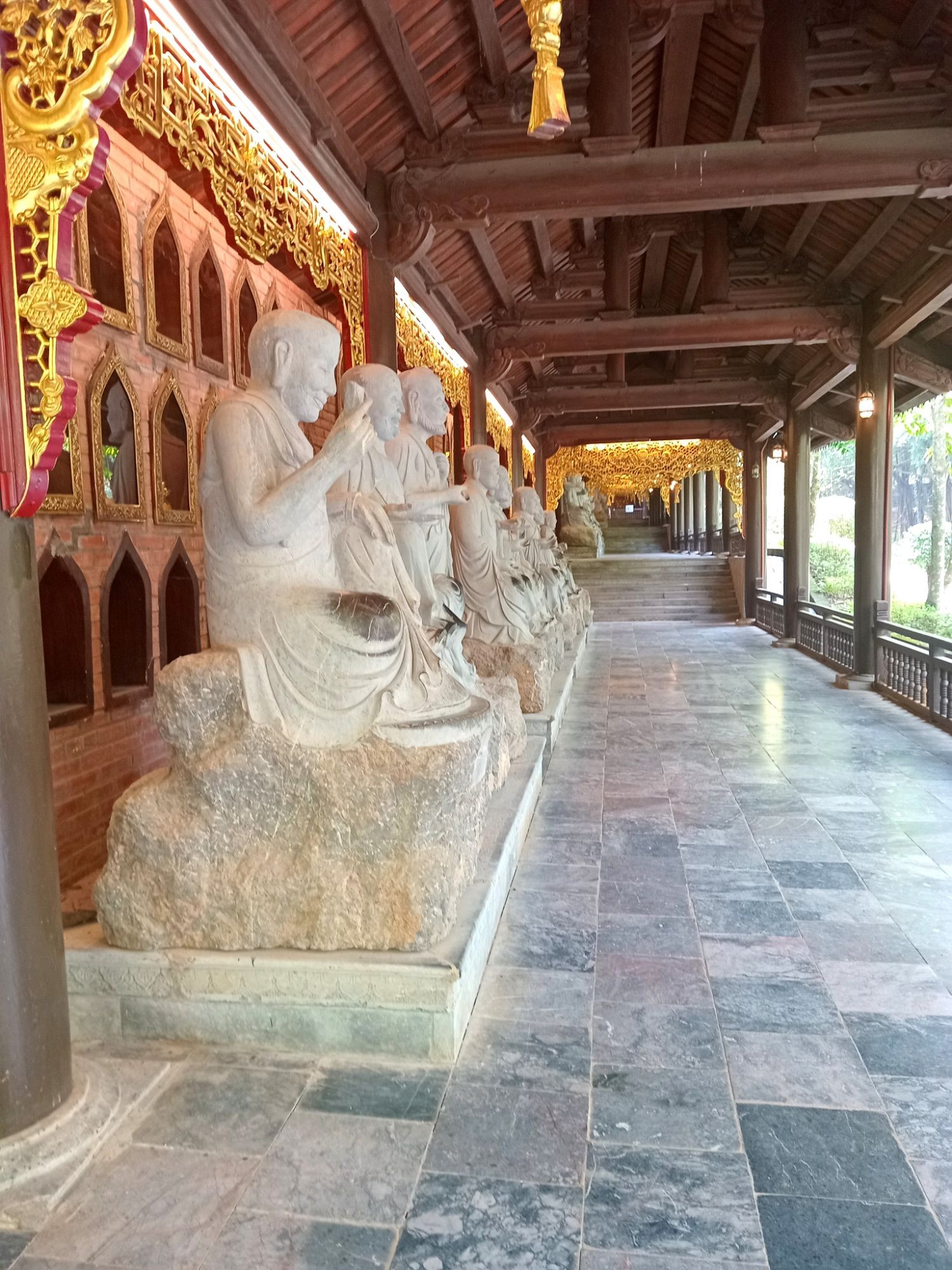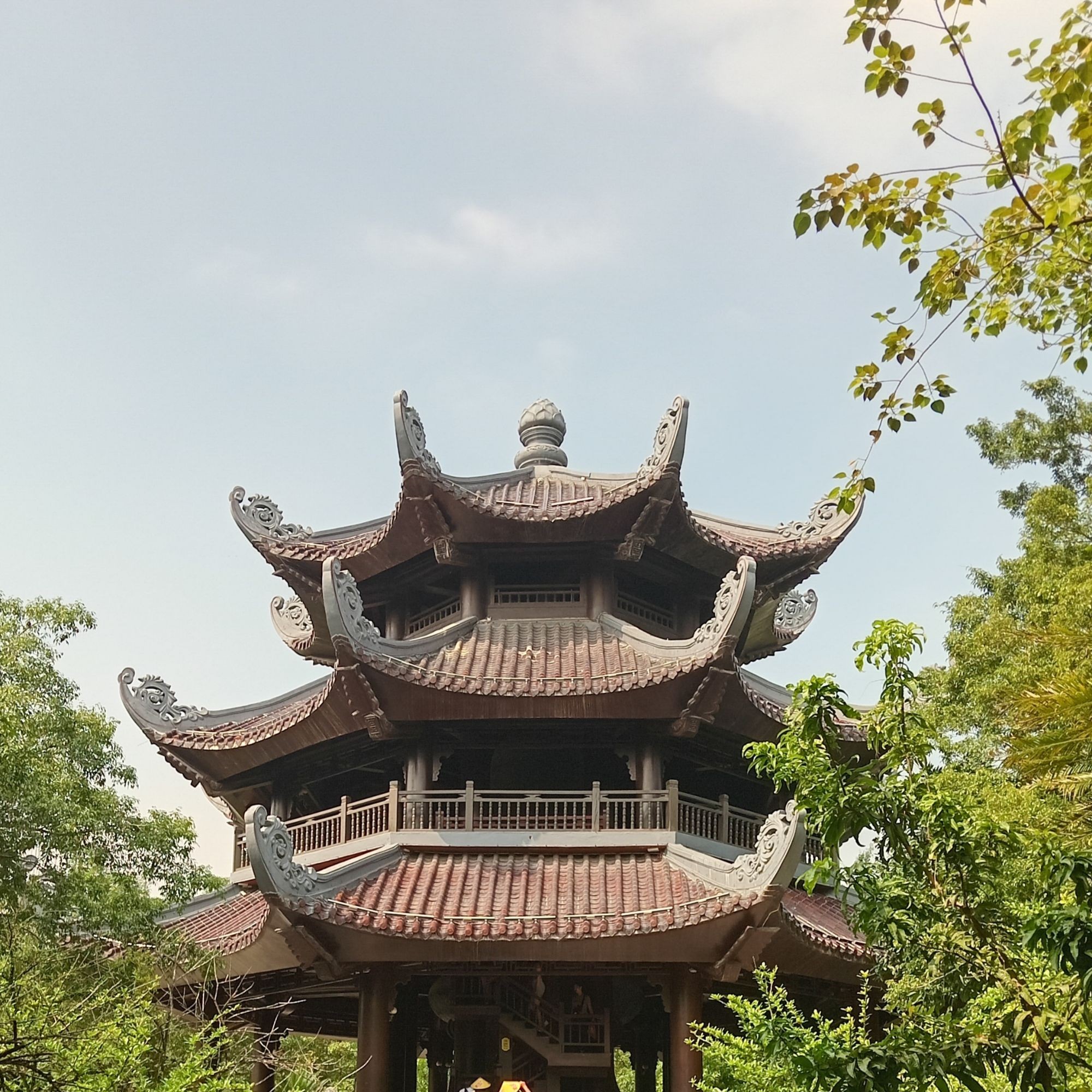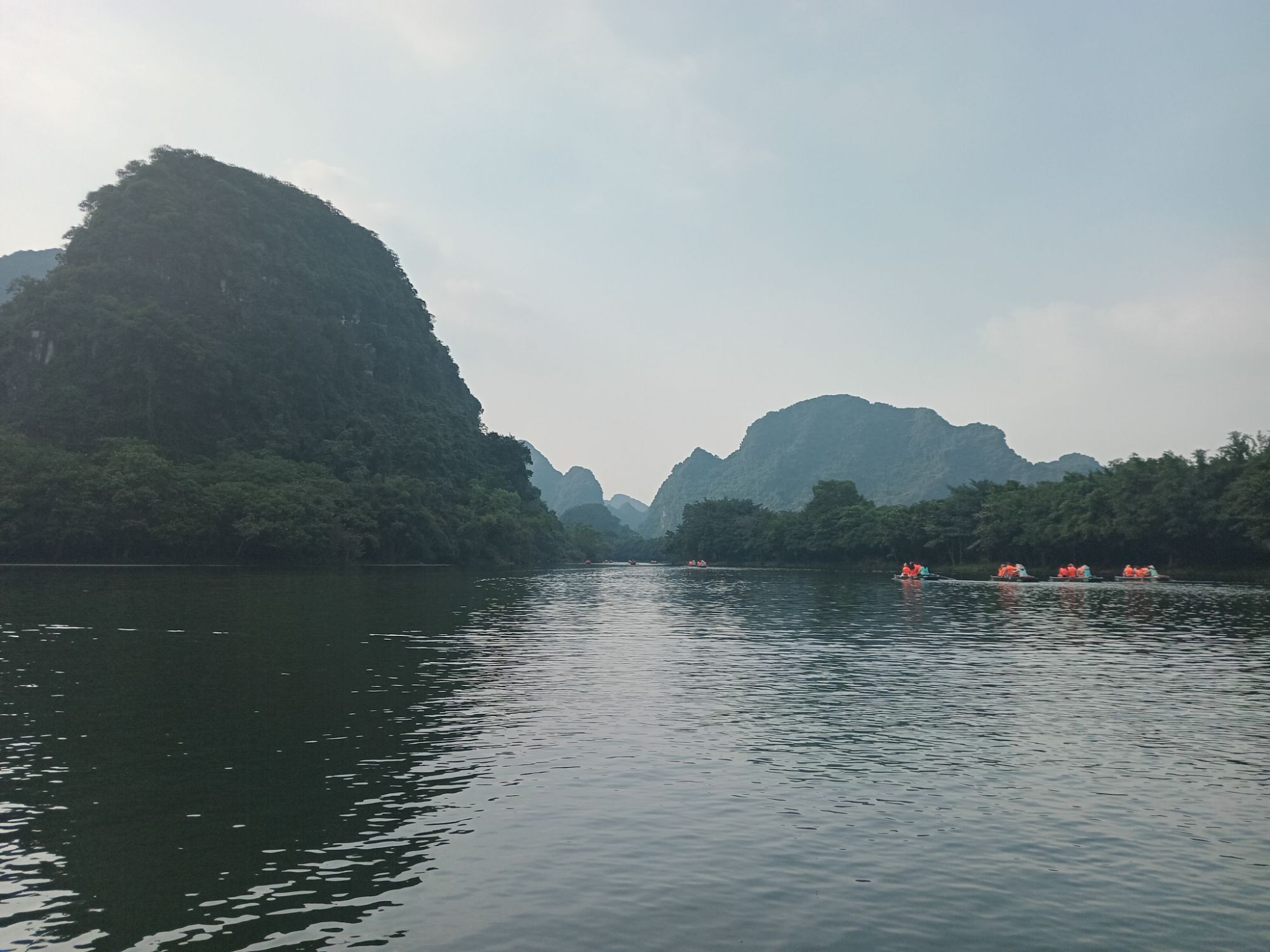Planning a visit to the magnificent Bai Dinh Pagoda complex in Ninh Binh, Vietnam? Wondering about its size and how much walking you’ll need to do? Absolutely, the Bai Dinh Pagoda complex is vast, but SIXT.VN can help you navigate it comfortably. This article will guide you through everything you need to know about exploring this spiritual landmark, ensuring a memorable and enjoyable experience. Get ready to explore Vietnam tourism at its finest!
1. Understanding the Scale of Bai Dinh Pagoda Complex
Is the Bai Dinh Pagoda complex very large? Yes, the Bai Dinh Pagoda complex is the largest Buddhist temple complex in Vietnam, covering a vast area of over 700 hectares. This expansive site includes both the original ancient temple and a newly constructed, much larger temple area. The scale of the complex is truly impressive, featuring numerous temples, halls, statues, and gardens. This makes it a significant pilgrimage destination and a major attraction for tourism in Vietnam.
1.1. Key Areas Within the Complex
The Bai Dinh Pagoda complex can be divided into several key areas, each offering unique sights and experiences:
-
The Ancient Pagoda: Nestled on Bai Dinh Mountain, this is the original temple, offering a serene and historical atmosphere.
-
The New Pagoda: This newer section boasts grand structures, including the Tam The Hall, Phap Chu Hall, and the Bell Tower.
-
The 500 Arhat Statues Corridor: A remarkable pathway featuring 500 unique Arhat statues, each with distinct expressions and poses.
-
The Great Bell Tower: Home to the largest bronze bell in Vietnam, offering panoramic views of the complex.
-
The Relic Stupa: An imposing structure housing precious Buddhist relics.
1.2. Why Size Matters
The sheer size of the Bai Dinh Pagoda complex is a significant factor for visitors. It means that exploring the entire site can take a considerable amount of time and energy. Understanding the scale helps in planning your visit effectively, ensuring you see the highlights without feeling overwhelmed.
2. Walking and Accessibility at Bai Dinh Pagoda
Is much walking involved? Yes, visiting Bai Dinh Pagoda involves a significant amount of walking. The complex is spread out, and while there are electric car services available, you’ll still need to walk to fully appreciate the intricate details and spiritual ambiance.
2.1. Walking Distances Between Attractions
-
Entrance to Main Halls: The distance from the main gate to the central temple area is substantial, requiring a walk of about 15-20 minutes, or a short ride on an electric car.
-
Arhat Corridor: Walking the entire 500 Arhat Statues Corridor can take over an hour, given its 3-kilometer length.
-
Ascending to the Ancient Pagoda: Reaching the original Bai Dinh Pagoda involves climbing a series of steps, which can be challenging for some visitors.
-
Bell Tower and Relic Stupa: These structures also require climbing stairs to reach the top for panoramic views.
2.2. Accessibility Options
To assist visitors, Bai Dinh Pagoda offers several accessibility options:
-
Electric Cars: These cars provide convenient transportation between the main areas of the complex, reducing the amount of walking required. SIXT.VN can arrange these services for you.
-
Wheelchair Accessibility: While the complex is vast, efforts have been made to provide wheelchair access to certain areas, though some areas remain challenging.
-
Rest Areas: There are designated rest areas throughout the complex where visitors can take a break and relax.
3. Planning Your Visit to Minimize Walking
To make the most of your visit to Bai Dinh Pagoda without exhausting yourself, consider these strategies:
3.1. Prioritize Key Attractions
Identify the attractions that are most important to you. Focus on visiting these first to ensure you don’t miss out due to fatigue.
3.2. Utilize Electric Car Services
Take advantage of the electric car services to cover large distances quickly. SIXT.VN can pre-book these services for you, ensuring a smooth and efficient visit.
3.3. Wear Comfortable Shoes
Comfortable footwear is essential. Choose shoes that provide good support and cushioning to make walking easier.
3.4. Stay Hydrated and Take Breaks
Bring water and stay hydrated throughout your visit. Take frequent breaks in the designated rest areas to avoid exhaustion.
3.5. Visit During Cooler Months
The best time to visit Ninh Binh is during the cooler months (October to April) to avoid the intense heat and humidity, making walking more comfortable.
4. Highlights of Bai Dinh Pagoda: What to See
Despite the extensive walking, the Bai Dinh Pagoda complex offers numerous attractions that are well worth the effort.
4.1. The 500 Arhat Statues Corridor
This corridor is a major highlight, featuring 500 intricately carved Arhat statues. Each statue is unique, showcasing different expressions and poses, making it a captivating and spiritual experience. According to the Vietnam Record Book Center, this is the longest Arhat corridor in Asia.
 The stunning 500 Arhat Statues corridor at Bai Dinh complex, adorned with diverse and expressive statues crafted by skilled artisans.
The stunning 500 Arhat Statues corridor at Bai Dinh complex, adorned with diverse and expressive statues crafted by skilled artisans.
4.2. The Great Bell Tower
The Bell Tower houses the largest bronze bell in Vietnam, weighing 36 tons. Climbing to the top of the tower offers stunning panoramic views of the entire complex and surrounding landscape. The Vietnam Record Book Center certified this bell as the largest of its kind in the country.
 The Bell-tower at Bai Dinh complex, a towering structure housing the largest bronze bell in Vietnam and offering panoramic views.
The Bell-tower at Bai Dinh complex, a towering structure housing the largest bronze bell in Vietnam and offering panoramic views.
4.3. The Shakyamuni Buddha Statue
Located in the Phap Chu Hall, the Shakyamuni Buddha statue is one of the largest bronze statues in Southeast Asia. Its sheer size and intricate details are awe-inspiring.
 Buddha Shakyamuni Statue, a massive bronze statue located in the Phap Chu Hall, symbolizing peace and enlightenment.
Buddha Shakyamuni Statue, a massive bronze statue located in the Phap Chu Hall, symbolizing peace and enlightenment.
4.4. The Mother of Compassion (Quan Am) Statue
This statue, dedicated to Quan Am (the Goddess of Mercy), is another impressive bronze structure. It symbolizes compassion and is a significant cultural and religious icon.
 Thousand-armed and thousand-eyed Mother of Compassion statue, a symbol of mercy and compassion at the Bai Dinh complex.
Thousand-armed and thousand-eyed Mother of Compassion statue, a symbol of mercy and compassion at the Bai Dinh complex.
5. Enhancing Your Visit with SIXT.VN
To ensure a seamless and enjoyable experience at Bai Dinh Pagoda, consider leveraging the services offered by SIXT.VN.
5.1. Pre-booked Transportation
SIXT.VN can arrange private car services to and from Bai Dinh Pagoda, providing a comfortable and stress-free journey. This is particularly beneficial given the distance from Hanoi and other nearby cities.
5.2. Electric Car Reservations
Navigate the vast complex with ease by pre-booking electric car services through SIXT.VN. This ensures you can quickly move between attractions without excessive walking.
5.3. Accommodation Assistance
SIXT.VN can help you find the perfect accommodation in Ninh Binh, whether you prefer a luxury resort or a budget-friendly hotel.
5.4. Guided Tours
Enhance your understanding and appreciation of Bai Dinh Pagoda with a guided tour arranged by SIXT.VN. Knowledgeable guides can provide insights into the history, architecture, and religious significance of the complex.
5.5. Combined Tours with Trang An
Maximize your Ninh Binh experience by combining a visit to Bai Dinh Pagoda with a boat tour of Trang An. SIXT.VN offers combined tour packages that streamline your itinerary and provide a comprehensive exploration of the region.
6. Exploring Trang An: A Complementary Experience
While visiting Bai Dinh Pagoda, consider including a trip to Trang An, a UNESCO World Heritage site known for its stunning natural beauty.
6.1. Boat Tours Through Karst Landscapes
Trang An offers serene boat tours through a network of caves and waterways, surrounded by towering limestone karst formations. It’s a relaxing and visually stunning experience. According to UNESCO, Trang An is “a spectacular landscape of limestone karst peaks permeated with valleys.”
 Starting the two-hour boat trip around Trang An, showcasing the serene waterways and dramatic karst landscapes of this UNESCO World Heritage site.
Starting the two-hour boat trip around Trang An, showcasing the serene waterways and dramatic karst landscapes of this UNESCO World Heritage site.
6.2. Key Attractions in Trang An
- The Cave System: Explore numerous caves with unique rock formations and historical significance.
- Temples and Pagodas: Visit ancient temples and pagodas nestled among the mountains.
- Paddy Fields: Admire the lush green paddy fields that add to the scenic beauty of the area.
6.3. Combining Bai Dinh and Trang An
Many tour operators, including SIXT.VN, offer day trips that combine visits to Bai Dinh Pagoda and Trang An. This allows you to experience both the spiritual grandeur of the pagoda and the natural beauty of Trang An in a single day.
7. Mua Caves: A Panoramic Viewpoint
For breathtaking views of Ninh Binh, consider a visit to Mua Caves.
7.1. Climbing to the Top
Reaching the summit of Mua Caves involves climbing 486 stone steps. While it can be challenging, the panoramic views of the surrounding landscape are well worth the effort.
7.2. Lotus Lake
At the foot of Mua Caves lies a beautiful lotus lake, adding to the charm of the area. Visit during the summer months to see the lotuses in full bloom.
7.3. Planning Your Visit
Allow at least 2-3 hours for a visit to Mua Caves, including the climb and time to enjoy the views. Wear comfortable shoes and bring water.
8. Cultural Etiquette and Respect
When visiting Bai Dinh Pagoda and other religious sites in Vietnam, it’s important to observe cultural etiquette and show respect.
8.1. Dress Code
Dress modestly, covering your shoulders and knees. Avoid wearing revealing clothing.
8.2. Behavior
Maintain a respectful demeanor. Speak quietly and avoid loud or disruptive behavior.
8.3. Photography
Be mindful when taking photographs. Avoid photographing people without their permission, and refrain from using flash photography inside temples.
8.4. Offerings
If you wish to make an offering, follow the local customs and guidelines. Offerings of incense, flowers, or money are common.
9. Accommodation Options in Ninh Binh
Finding the right accommodation is crucial for a comfortable visit. Ninh Binh offers a range of options to suit different budgets and preferences.
9.1. Luxury Resorts
For a luxurious experience, consider staying at one of Ninh Binh’s high-end resorts, such as:
-
Emeralda Resort Ninh Binh: Offers beautiful rooms, a spa, and multiple dining options.
-
Ninh Binh Hidden Charm Hotel & Resort: Features stunning views, a pool, and excellent service.
9.2. Mid-Range Hotels
Mid-range hotels provide a good balance of comfort and affordability. Some popular options include:
-
Nguyen Shack Ninh Binh: Offers unique bungalow-style accommodation in a scenic setting.
-
Tam Coc Garden Resort: Features charming rooms and a peaceful garden.
9.3. Budget-Friendly Options
For budget travelers, there are plenty of guesthouses and hostels in Ninh Binh that offer clean and comfortable accommodation at affordable prices.
10. Local Cuisine: What to Eat in Ninh Binh
No visit to Ninh Binh is complete without sampling the local cuisine.
10.1. Com Chay (Crispy Rice)
Com Chay is a local specialty made from crispy fried rice, often served with meat and vegetables.
10.2. Goat Meat Dishes
Ninh Binh is known for its goat meat dishes, such as goat with lemon and grilled goat.
10.3. Eel Vermicelli (Bun Luon)
Bun Luon is a flavorful noodle soup made with eel, a local favorite.
10.4. Nem Chua (Fermented Pork Roll)
Nem Chua is a popular snack made from fermented pork, often served with chili sauce.
11. Practical Information for Your Trip
11.1. Getting to Ninh Binh
Ninh Binh is easily accessible from Hanoi by train, bus, or private car. The journey takes approximately 2-3 hours. SIXT.VN can arrange transportation for you.
11.2. Visa Requirements
Check visa requirements for Vietnam based on your nationality. Many nationalities can enter Vietnam visa-free for a certain period.
11.3. Currency
The local currency is the Vietnamese Dong (VND). Credit cards are accepted in larger establishments, but it’s a good idea to carry cash for smaller shops and restaurants.
11.4. Language
The official language is Vietnamese. English is spoken in tourist areas, but learning a few basic Vietnamese phrases can be helpful.
11.5. Health and Safety
Consult your doctor about necessary vaccinations and health precautions. Drink bottled water and be cautious about street food.
12. Sustainable Tourism Practices
When visiting Bai Dinh Pagoda and Ninh Binh, consider adopting sustainable tourism practices to minimize your impact on the environment and local communities.
12.1. Respect Local Culture
Show respect for local customs and traditions.
12.2. Reduce Waste
Avoid single-use plastics and dispose of your waste responsibly.
12.3. Support Local Businesses
Eat at local restaurants and buy souvenirs from local artisans.
12.4. Conserve Resources
Conserve water and energy.
13. Conclusion: Embark on Your Bai Dinh Adventure
The Bai Dinh Pagoda complex is a destination of immense scale and spiritual significance, with much walking involved to fully appreciate its grandeur. With careful planning and the assistance of SIXT.VN, you can navigate the complex comfortably and enjoy a memorable experience. From the stunning Arhat corridor to the panoramic views from the Bell Tower, Bai Dinh offers a wealth of cultural and religious treasures. So, pack your comfortable shoes, book your tour with SIXT.VN, and prepare to be amazed by the beauty and spirituality of Bai Dinh Pagoda!
14. FAQs About Visiting Bai Dinh Pagoda
14.1. How much time do I need to visit Bai Dinh Pagoda?
A full visit to Bai Dinh Pagoda requires at least 4-6 hours to see the main attractions, including the Arhat corridor and temples.
14.2. Are there entrance fees for Bai Dinh Pagoda?
Entrance to Bai Dinh Pagoda is free, but there are fees for electric car services and the Bell Tower.
14.3. What is the best time of year to visit Ninh Binh and Bai Dinh Pagoda?
The best time to visit is during the cooler months from October to April to avoid extreme heat and humidity.
14.4. Can I visit Bai Dinh Pagoda and Trang An in one day?
Yes, it is possible to visit both Bai Dinh Pagoda and Trang An in one day with a well-planned tour.
14.5. Are there dress code requirements for visiting Bai Dinh Pagoda?
Yes, visitors should dress modestly, covering shoulders and knees.
14.6. Is Bai Dinh Pagoda wheelchair accessible?
Some areas are wheelchair accessible, but the entire complex may be challenging for wheelchair users.
14.7. Are there restaurants and food options at Bai Dinh Pagoda?
Yes, there are restaurants and food stalls near the entrance of the complex.
14.8. Can SIXT.VN help me plan my trip to Bai Dinh Pagoda?
Yes, SIXT.VN offers services such as transportation, electric car reservations, accommodation assistance, and guided tours to make your visit seamless.
14.9. What are the opening hours of Bai Dinh Pagoda?
Bai Dinh Pagoda is generally open from 7:00 AM to 6:00 PM daily.
14.10. Is it necessary to hire a guide for Bai Dinh Pagoda?
While not required, hiring a guide can enhance your understanding and appreciation of the complex’s history and significance. SIXT.VN can arrange knowledgeable guides for you.
Ready to explore the majestic Bai Dinh Pagoda and the stunning landscapes of Ninh Binh? Let SIXT.VN take care of all your travel needs!
- Address: 260 Cau Giay, Hanoi, Vietnam
- Hotline/WhatsApp: +84 986 244 358
- Website: SIXT.VN
Contact us today to book your personalized tour and experience the best of Vietnam!



